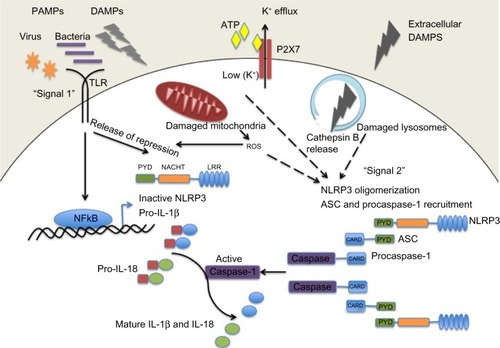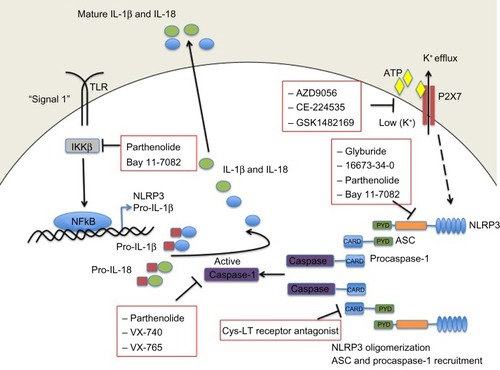Figures & data
Table 1 Inflammasome-forming NLRs in humans and mice
Table 2 Sterile inflammatory NLRP3 activators and associated diseases
Figure 1 NLRP3 inflammasome activation. Pathogenic PAMPs from virus or bacteria, or sterile DAMPs “prime” the inflammasome by activating a TLR inducing NFκB activation and the expression of NLRP3 and pro-IL-1β (signal 1). NLRP3 oligomerizes and recruits ASC and procaspase-1 in response to an activation signal (signal 2). NLRP3 can be activated in response to potassium ion efflux through the ATP-gated P2X7 channel, in response to reactive oxygen species released from damaged mitochondria, or in response to cathepsin B release from damaged lysosomes. Once activated the NLRP3 inflammasome causes the activation of caspase-1 which cleaves the precursor proforms of IL-1β and IL-18 into their mature forms.
Abbreviations: ASC, apoptosis-related speck-like protein containing a caspase recruitment domain; ATP, adenosine triphosphate; CARD, caspase recruitment domain; DAMPS, danger or damage associated molecular patterns; IL, interleukin; LRR, leucine-rich repeat; NACHT, central nucleotide-binding and oligomerization; NF-κB, nuclear factor kappa B; P2X7, P2X purinergic receptor 7; PAMPS, pathogen associated molecular patterns; PYD, pyrin domain; ROS, reactive oxygen species; TLR, Toll-like receptor.

Table 3 Some common NLRP3 mutations identified with associated diseases
Table 4 Therapeutic agents that inhibit inflammasome components and their targeted diseases
Figure 2 Small-molecule blockade of the NLRP3 inflammasome. Cartoon depicting the mode of action of the various small molecule inhibitors described in detail in the text.
Abbreviations: ASC, apoptosis-related speck-like protein containing a caspase recruitment domain; ATP, adenosine triphosphate; CARD, caspase recruitment domain; Cys-LT, cysteinyl leukotriene; IKKβ, inhibitor of κB kinase β; IL, interleukin; NF-κB, nuclear factor kappa B; P2X7, P2X purinergic receptor 7; PYD, pyrin domain; TLR, Toll-like receptor.

